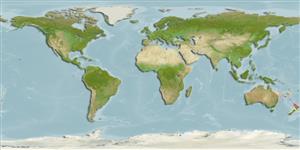Common names from other countries
Environment: milieu / climate zone / depth range / distribution range
Ökologie
seewasser riff-verbunden; tiefenbereich 13 - 100 m (Ref. 9710). Subtropical; 20°S - 47°S
Western Pacific: New Caledonia, New South Wales in Australia, Norfolk Island, northeast coast of New Zealand, and Kermadec Islands (Ref. 8879). Also recorded in Japan (Ref. 59123) and Ogasawara Is. (Ref. 26066).
Size / Gewicht / Alter
Maturity: Lm ? range ? - ? cm
Max length : 13.5 cm TL Männchen/unbestimmt; (Ref. 9710)
Rückenflossenstacheln (insgesamt): 9; Rückenflossenweichstrahlen (insgesamt): 11; Afterflossenstacheln 3; Afterflossenweichstrahlen: 10; Wirbelzahl: 25. Head with two slightly oblique blue bands extending downward from lower part of opercle onto inter opercle. Dorsal fin red, base and postventral part, yellowish; anal fin deep burgundy-red; caudal fin upper part yellow, lower red; pectorals hyaline with thin red lines on rays, base yellow; pelvic fins blue. With five predorsal scales (rarely 3 or 4); two cheek scale rows behind the eye, three below the eye.
Occurs inshore (Ref. 75154). Found in sand patches of shallow reefs but has been reported to occur up to a depth of 100 m (Ref. 530). Minimum depth from Ref. 58018.
Life cycle and mating behavior
Geschlechtsreife | Fortpflanzung | Ablaichen | Eier | Fecundity | Larven
Oviparous, distinct pairing during breeding (Ref. 205).
Russell, B.C., 1985. Revision of the Indo-Pacific labrid fish genus Suezichthys, with descriptions of four new species. Indo-Pac. Fish. (2):21 p. (Ref. 530)
IUCN Rote Liste Status (Ref. 130435)
CITES (Ref. 128078)
Not Evaluated
Bedrohung für Menschen
Harmless
Nutzung durch Menschen
Mehr Information
ReferenzenAquakulturAquakultur ProfilZuchtlinienGenetikElectrophoresesVererbbarkeitKrankheitenVerarbeitungMass conversion
PartnerBilderStamps, Coins Misc.LauteCiguateraGeschwindigkeitSchwimmstilKiemenoberflächeOtolithsGehirngrößeSehfähigkeit
Tools
Zusatzinformationen
Download XML
Internet Quellen
Estimates based on models
Preferred temperature (Ref.
115969): 17.6 - 24.3, mean 20.2 (based on 13 cells).
Phylogenetic diversity index (Ref.
82804): PD
50 = 0.5002 [Uniqueness, from 0.5 = low to 2.0 = high].
Bayesian length-weight: a=0.00501 (0.00207 - 0.01214), b=3.15 (2.94 - 3.36), in cm Total Length, based on LWR estimates for this (Sub)family-body shape (Ref.
93245).
Trophic level (Ref.
69278): 3.5 ±0.37 se; based on food items.
Widerstandsfähigkeit (Ref.
120179): hoch, Verdopplung der Population dauert weniger als 15 Monate. (Preliminary K or Fecundity.).
Fishing Vulnerability (Ref.
59153): Low vulnerability (10 of 100).
